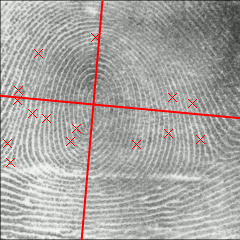
Spatial Pattern Indexes
Spatial Pattern indexes are designed to accommodate needs for biometrics pattern matching. Falling into the same category as spatial indexes, pattern indexes allow for a series of two or three dimensional control points to be matched against another.
 For example in the picture to the left, where a finger print has been analysed to find a
relative centre and x y axis, we can find a series of control points that describe the unique
features of each print. Once the pattern has been entered into the database, this index structure
allows for a partial or complete matching of the same series of control points, within a specified
error margin.
For example in the picture to the left, where a finger print has been analysed to find a
relative centre and x y axis, we can find a series of control points that describe the unique
features of each print. Once the pattern has been entered into the database, this index structure
allows for a partial or complete matching of the same series of control points, within a specified
error margin.
This index regime as been implemented for both two and three dimensions, allow for two dimensional patterns such as finger prints and also three dimensional patterns such as facial recognition.
The Pattern index works in a similar manner to the standard Spatial Tree index described above. The nodes structure is identical in both instances and only differs in the leaf structure, where only the control points are saved from each pattern series. Searching is also done in a similar way for both indexes, where only paths that are bounded by the area described in the node are followed – this reduces the amount pages read for each search. But unlike searching with Spatial Trees where overlapping regions are matched, in Pattern indexes only the control points within the margin of error are returned.


